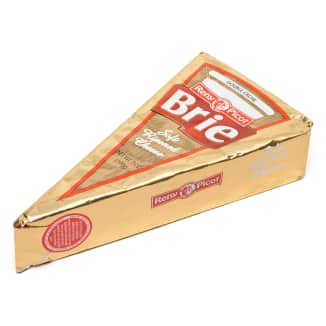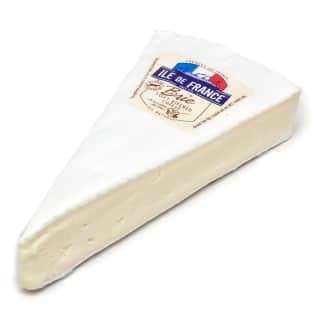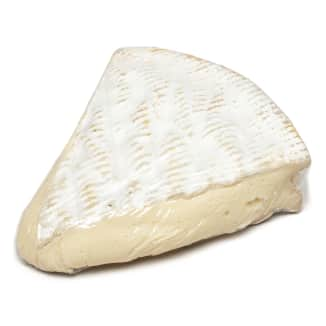Reviews You Can Trust.
See Why.
Supermarket Brie
Think French pedigree and words like “triple crème” indicate the best examples of this cheese plate favorite? So did we—until we learned that good Brie is a matter of culture.

Top Pick

WinnerFromager D’Affinois
Sign up for the Well-Equipped Cook newsletter
Shop smarter with our ATK Reviews team's expert guides and recommendations.
What You Need to Know
A few decades ago, Brie was the pinnacle of sophistication on American cheese plates. Its longtime French reputation as the “cheese of kings,” coupled with its lush, buttery, not-too-pungent profile and velvety edible rind, made it at once fashionable and approachable. But Brie sold in America has changed over the years. The original name-protected versions have been banned by the U.S. Food and Drug Administration (FDA) for using raw milk, and these days most products found in supermarkets are produced domestically. You’re also increasingly likely to find specimens that are bland, rubbery, and encased in rinds as stiff as cardboard. And yet, if there was a creamy, satiny, richly flavorful Brie available in the average grocery store, we wanted to know about it. So we gathered 10 nationally available brands that ranged broadly in price (from $5.92 to $19.98 per pound), purposely selecting cheeses that spanned a variety of traits that we thought might affect flavor and texture—in particular, fat content (we included standard-fat, double, and triple crème cheeses), nationality (American or French), and format (some are sold as small wheels, others as wedges cut from larger wheels). We sampled the Bries plain at room temperature (the ideal serving temperature) and also baked into phyllo cups with dollops of red currant jelly to see how the cheeses behaved when heated.
Process of Elimination
We could tell just by handling the cheeses that their textures varied considerably: Wheels and wedges alike ranged from soft and pliable to almost rigid. When we tasted the cheeses, we found that their flavors varied just as much—some were “boring,” with “almost no flavor,” while others tasted “mushroomy” and “nutty-rich.” Heating the cheeses only underscored these differences: Fuller flavors intensified and creamier textures became even plusher, while bland cheeses tasted the same and barely melted at all. When we tallied the scores, we were pleased to find that we could recommend without reservation four out of the 10 cheeses—in particular, a standout wedge that embodied everything we want in Brie: a lush, buttery, full-flavored interior encased in a pillowy rind.
But surprisingly, factors like origin, price, and format had no bearing on our preferences. Though our favorite was a wedge from France, our runner-up was an 8-ounce wheel made in California. And a bargain wedge from Michigan outranked French Bries costing two or three times as much.
We also assumed that Bries labeled triple and double crème would taste richer and creamier than standard-fat cheeses—but that wasn’t always the case. Though cream is generally added to the milk when making both double and triple crèmes, the amount can vary substantially within each category. (Triple crèmes contain upwards of 75 percent butterfat while double crèmes range from 60 to 75 percent.)
Culture Shock
It wasn’t until we dug deeper into the Brie-making process that we uncovered the key factor explaining what gave a cheese the lush texture and earthy flavor we liked best: the culturing process. Cultures in the milk and on the exterior of the Brie react with the milk proteins as the cheese ages—a process called proteolysis—and cause the proteins to break down. This results in a rind forming on the wheel and its interior softening and developing flavor from the outside in, a process known as surface-ripening.
According to Dean Sommer and Mark Johnson at the University of Wisconsin-Madison’s Center for Dairy Research, the nature of that ripening—and the flavor and texture of Brie—largely depends on the type of cultures a cheesemaker uses. French appellation d’origine contrôlée (AOC) Bries are made exclusively with raw milk, which can contain enough natural bacteria to culture the cheese. But Bries made with pasteurized milk need added cultures. These fall into two main strains, mesophilic or thermophilic. Mesophilic cultures are more reactive with milk proteins and lead to so-called traditional Brie that more closely mimics the AOC raw-milk cheese with fuller flavor, gooier texture, and a thinner, spottier rind. Thermophilic cultures are less reactive and create milder, firmer cheese with a thicker, more uniform rind. Such cheeses are referred to as “stabilized” in the industry.
Since labels don’t indicate whether a Brie is traditional or stabilized, we asked each manufacturer directly—and among those that answered, we saw a pattern. Most of our top-ranking cheeses were traditional, which correlated with our tasters’ preferences for Brie with creamier body and somewhat fuller flavor, while stabilized cheeses dominated the middle and bottom of the pack. What’s more, the makers of our top two Bries add Geotrichum, a yeast-like fungus that is naturally present in raw milk, which contributes to a gooey, silky texture, more delicate rind, and rich, earthy flavor with less bitterness.
So why would a manufacturer make a stabilized Brie? For one thing, there’s a market demand for blander cheese both here and in France (where stabilized Brie is often fed to schoolchildren). Another more compelling reason is quality control: As long as a wheel of traditional Brie is left uncut, it will continue to soften and develop flavor, so makers must rely on supermarket staff to handle and rotate the stock appropriately. Stabilized Brie, on the other hand, will remain consistently firm and mild as it sits at the store.
The makers of our winner wouldn’t confirm that their cheese is made with mesophilic cultures but its silky body, buttery-rich flavor, and downy-soft rind are the qualities that we associate with traditional Brie. It’s a double crème that we’ll happily seek out for our cheese plates.
America's Test KitchenWatch Now
Everything We Tested
Highly Recommended

WinnerFromager D’Affinois
Recommended

Marin Triple Crème Brie

Fromage de Meaux

Reny Picot Brie
Recommended with reservations

Alouette Double Crème Brie

Brie d’Isigny

Président Brie

Joan Of Arc Double Crème Brie
Not Recommended

Ile de France Brie

Brie de Nangis
*All products reviewed by America’s Test Kitchen are independently chosen, researched, and reviewed by our editors. We buy products for testing at retail locations and do not accept unsolicited samples for testing. We list suggested sources for recommended products as a convenience to our readers but do not endorse specific retailers. When you choose to purchase our editorial recommendations from the links we provide, we may earn an affiliate commission. Prices are subject to change.
Reviews You Can Trust
The mission of America’s Test Kitchen Reviews is to find the best equipment and ingredients for the home cook through rigorous, hands-on testing. Have a question or suggestion? Send us an email at atkreviews@americastestkitchen.com. We appreciate your feedback!
The Expert

byKate Shannon Levine
Editorial Director, ATK Reviews
Kate is the editorial director for ATK Reviews. She's a culinary school graduate and former line cook and cheesemonger.
Kate Shannon Levine is the editorial director for ATK Reviews. She’s covered a wide variety of topics at America’s Test Kitchen, but she especially loves writing about cheese, pantry staples such as anchovies and kosher salt, and cleaning products. One of her proudest accomplishments is finding a life-changing kitchen sponge (really) and proving once and for all that it's a bad idea to leave a soggy sponge in the bottom of your sink. Prior to joining America’s Test Kitchen, she attended Boston University’s culinary program and worked as both a line cook and a cheesemonger.
Reviews You Can Trust.
See Why.




